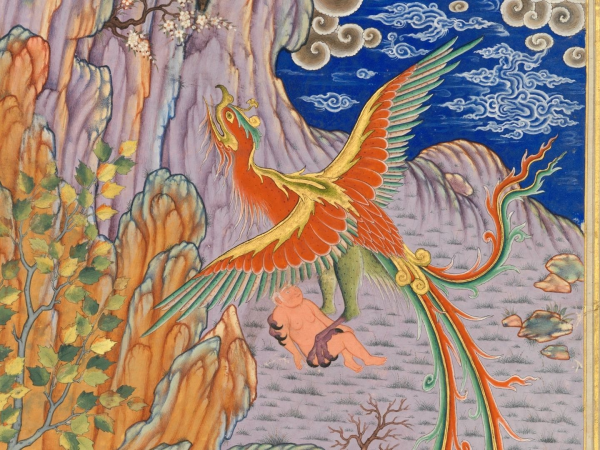Persian Miniature Painting: Zal & the Simurgh
The epic poem of Zal and the Simurgh is one of the most famous parts of the Shahnameh, the Persian Book of Kings. Rejected by his father, Zal is brought up by the Simurgh (phoenix) and grows up to be one of the most important characters of the Shahnameh, and in turn his son, the legendary Rustam, becomes one of the main heroes of the epic. The myth of Zal is therefore of great importance as it sets the scene for things to come.
In this course, we will be working from the famous Zal and the Simurgh painting by Sadiqi with its beautiful crystalline rocks and jewel-like colours.
The pleasure of concentrating on a single miniature for a period of time involves us deeply. We are immersed in it; we live with it; we live in it. Inhabiting and internalising a painting in this way is a wonderful and traditional way to learn. In today’s fast-paced world we need to sit, focus on and contemplate our single piece and grow to love and understand it. We will understand the subtle art of colour, composition and blending by our action of making and doing, connecting with the work. The aim is not to rush, but to dwell. Thus painting is a form of meditation in itself. Students are invited to recreate this alongside the tutor, incorporate elements into existing work or be inspired to create their own compositions.
Booking Options
The epic poem of Zal and the Simurgh is one of the most famous parts of the Shahnameh, the Persian Book of Kings. Rejected by his father, Zal is brought up by the Simurgh (phoenix) and grows up to be one of the most important characters of the Shahnameh, and in turn his son, the legendary Rustam, becomes one of the main heroes of the epic. The myth of Zal is therefore of great importance as it sets the scene for things to come.
In this course, we will be working from the famous Zal and the Simurgh painting by Sadiqi with its beautiful crystalline rocks and jewel-like colours.
The pleasure of concentrating on a single miniature for a period of time involves us deeply. We are immersed in it; we live with it; we live in it. Inhabiting and internalising a painting in this way is a wonderful and traditional way to learn. In today’s fast-paced world we need to sit, focus on and contemplate our single piece and grow to love and understand it. We will understand the subtle art of colour, composition and blending by our action of making and doing, connecting with the work. The aim is not to rush, but to dwell. Thus painting is a form of meditation in itself. Students are invited to recreate this alongside the tutor, incorporate elements into existing work or be inspired to create their own compositions.




